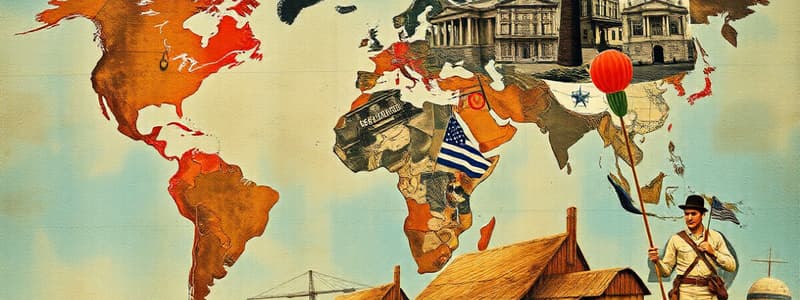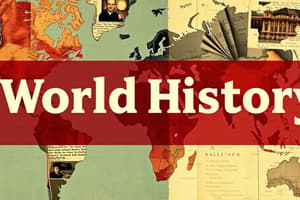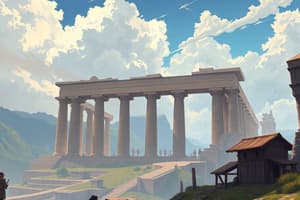Podcast
Questions and Answers
What was one of the primary causes of the growth of exchange networks during the period from c. 1200 to c. 1450?
What was one of the primary causes of the growth of exchange networks during the period from c. 1200 to c. 1450?
- The rise of feudalism in Western Europe
- Cultural isolation of different regions
- The establishment of trade routes in the Indian Ocean (correct)
- Increased agricultural production in Europe
Which factor had a long-term impact as a result of the Mongolian invasions?
Which factor had a long-term impact as a result of the Mongolian invasions?
- Enhancement of cultural exchange across continents (correct)
- Isolation of Central Asian tribes
- Decline of trade along the Silk Roads
- Strengthening of regional monarchies in Europe
What was a major cultural consequence of connectivity during exchange networks?
What was a major cultural consequence of connectivity during exchange networks?
- Diverse interactions among different cultures (correct)
- Technological stagnation in Africa
- Complete isolation of trade hubs
- Uniform religion across all regions
What was one of the environmental consequences of exchange networks?
What was one of the environmental consequences of exchange networks?
Which statement best describes the similarities among networks of exchange during this period?
Which statement best describes the similarities among networks of exchange during this period?
What is one potential limitation of the EPUB conversion process mentioned?
What is one potential limitation of the EPUB conversion process mentioned?
Which of the following best describes the primary goal of the Internet Archive?
Which of the following best describes the primary goal of the Internet Archive?
How does the page numbering in the EPUB format relate to the print edition?
How does the page numbering in the EPUB format relate to the print edition?
What are users warned about regarding scanning errors in the EPUB format?
What are users warned about regarding scanning errors in the EPUB format?
What action must pupils take regarding the textbooks issued to them?
What action must pupils take regarding the textbooks issued to them?
What kind of specialized services does the Internet Archive provide?
What kind of specialized services does the Internet Archive provide?
Which term is NOT mentioned as a condition to describe the state of issued textbooks?
Which term is NOT mentioned as a condition to describe the state of issued textbooks?
When was the Internet Archive founded?
When was the Internet Archive founded?
What was the primary emphasis of Daoism in Chinese culture?
What was the primary emphasis of Daoism in Chinese culture?
Which dynasty is known for establishing centralized control in China?
Which dynasty is known for establishing centralized control in China?
During which dynasty did China experience a Golden Age characterized by peace and population growth?
During which dynasty did China experience a Golden Age characterized by peace and population growth?
What was one of the significant technological advancements during the Han Dynasty?
What was one of the significant technological advancements during the Han Dynasty?
What was the primary purpose of the civil service exam created during the Han Dynasty?
What was the primary purpose of the civil service exam created during the Han Dynasty?
Cyrus the Great is known for founding which empire?
Cyrus the Great is known for founding which empire?
What characterized the political landscape of ancient Greece?
What characterized the political landscape of ancient Greece?
What was a common feature of the Persian Empire under Cyrus the Great?
What was a common feature of the Persian Empire under Cyrus the Great?
What is the main purpose of reviewing essential concepts for the exam?
What is the main purpose of reviewing essential concepts for the exam?
How many short-answer questions (SAQs) will be included in the AP® World History: Modern exam?
How many short-answer questions (SAQs) will be included in the AP® World History: Modern exam?
Which type of stimulus is included in the second required short-answer question?
Which type of stimulus is included in the second required short-answer question?
What time frame does the Document-Based Question (DBQ) cover?
What time frame does the Document-Based Question (DBQ) cover?
Which of the following is NOT a requirement for answering the DBQ?
Which of the following is NOT a requirement for answering the DBQ?
What is the focus of short-answer question 4?
What is the focus of short-answer question 4?
How many documents are provided in the DBQ portion of the exam?
How many documents are provided in the DBQ portion of the exam?
What is one component required for a historically defensible thesis in the DBQ?
What is one component required for a historically defensible thesis in the DBQ?
What was a significant impact of the Green Revolution on global agriculture?
What was a significant impact of the Green Revolution on global agriculture?
How did emerging diseases in the 20th century challenge economic stability?
How did emerging diseases in the 20th century challenge economic stability?
What role did the United Nations play in global peace efforts?
What role did the United Nations play in global peace efforts?
Which of the following is an example of social resistance to globalization?
Which of the following is an example of social resistance to globalization?
What was a primary characteristic of the economic changes seen in the global age?
What was a primary characteristic of the economic changes seen in the global age?
Which factor contributed to environmental changes in the 20th century?
Which factor contributed to environmental changes in the 20th century?
What is a significant aspect of global consumer culture in recent decades?
What is a significant aspect of global consumer culture in recent decades?
What has been a critical outcome of the calls for reform regarding human rights?
What has been a critical outcome of the calls for reform regarding human rights?
What is the minimum number of documents required to achieve a top score in a DBQ response?
What is the minimum number of documents required to achieve a top score in a DBQ response?
Which aspect of documents must be analyzed for effective sourcing in a DBQ?
Which aspect of documents must be analyzed for effective sourcing in a DBQ?
What is a common mistake made by writers when answering a DBQ?
What is a common mistake made by writers when answering a DBQ?
What should the structure of a DBQ response be based on?
What should the structure of a DBQ response be based on?
What additional knowledge should be included in a DBQ response?
What additional knowledge should be included in a DBQ response?
Why is it important to analyze the historical situation of a document in a DBQ?
Why is it important to analyze the historical situation of a document in a DBQ?
What is an essential component of a thesis statement in a DBQ?
What is an essential component of a thesis statement in a DBQ?
What is the primary difference between a DBQ response and a long essay?
What is the primary difference between a DBQ response and a long essay?
Flashcards
EPUB Format
EPUB Format
This refers to the conversion of scanned book pages into an EPUB (Electronic Publication) format.
Optical Character Recognition (OCR)
Optical Character Recognition (OCR)
A process where scanned images of text are converted to machine-readable characters.
OCR Errors
OCR Errors
Potential errors arising during OCR that can lead to incorrect reading sequences, weird characters, and misspelled words.
Internet Archive
Internet Archive
Signup and view all the flashcards
Internet Archive's Mission
Internet Archive's Mission
Signup and view all the flashcards
Accessibility Services
Accessibility Services
Signup and view all the flashcards
Improving Scanning Process
Improving Scanning Process
Signup and view all the flashcards
Universal Access to Knowledge
Universal Access to Knowledge
Signup and view all the flashcards
Decolonization
Decolonization
Signup and view all the flashcards
Advances in Technology and Exchange
Advances in Technology and Exchange
Signup and view all the flashcards
Globalization
Globalization
Signup and view all the flashcards
Emerging Epidemics
Emerging Epidemics
Signup and view all the flashcards
Free-Market Economies
Free-Market Economies
Signup and view all the flashcards
Human Rights
Human Rights
Signup and view all the flashcards
Globalized Culture
Globalized Culture
Signup and view all the flashcards
Anti-Globalization
Anti-Globalization
Signup and view all the flashcards
What were the Silk Roads?
What were the Silk Roads?
Signup and view all the flashcards
What caused the growth of exchange networks?
What caused the growth of exchange networks?
Signup and view all the flashcards
How did the Mongols influence exchange networks?
How did the Mongols influence exchange networks?
Signup and view all the flashcards
How did trade networks influence West Africa?
How did trade networks influence West Africa?
Signup and view all the flashcards
What were some negative consequences of exchange networks?
What were some negative consequences of exchange networks?
Signup and view all the flashcards
Document-Based Question (DBQ)
Document-Based Question (DBQ)
Signup and view all the flashcards
Thesis Statement
Thesis Statement
Signup and view all the flashcards
Outside Knowledge
Outside Knowledge
Signup and view all the flashcards
Short-Answer Question (SAQ)
Short-Answer Question (SAQ)
Signup and view all the flashcards
Thesis Statement
Thesis Statement
Signup and view all the flashcards
Sourcing
Sourcing
Signup and view all the flashcards
Document Evidence
Document Evidence
Signup and view all the flashcards
Historical Context
Historical Context
Signup and view all the flashcards
Document Organization
Document Organization
Signup and view all the flashcards
Point of View (POV)
Point of View (POV)
Signup and view all the flashcards
Purpose of Document
Purpose of Document
Signup and view all the flashcards
Historical Situation
Historical Situation
Signup and view all the flashcards
Document Creator
Document Creator
Signup and view all the flashcards
Outside Evidence
Outside Evidence
Signup and view all the flashcards
Complex Understanding
Complex Understanding
Signup and view all the flashcards
Document Purpose
Document Purpose
Signup and view all the flashcards
Han Dynasty Golden Age
Han Dynasty Golden Age
Signup and view all the flashcards
Qin Dynasty Standardized System
Qin Dynasty Standardized System
Signup and view all the flashcards
Daoism's Emphasis
Daoism's Emphasis
Signup and view all the flashcards
Religious Toleration
Religious Toleration
Signup and view all the flashcards
Persian Empire
Persian Empire
Signup and view all the flashcards
Standardized Chinese Script
Standardized Chinese Script
Signup and view all the flashcards
Han Dynasty Civil Service Exam
Han Dynasty Civil Service Exam
Signup and view all the flashcards
Chang'an
Chang'an
Signup and view all the flashcards
Study Notes
AP World History: Modern - Study Notes
-
Book Format & Errors: The book is in EPUB format, generated automatically from scanned pages. Optical character recognition (OCR) might introduce errors, impacting reading order, character recognition, and page numbering. Internet Archive is working to improve the process.
-
Textbook Usage: The book is property of a specific school district, and pupils are prohibited from writing in it except for specified consumable textbooks. Book condition should also be documented (e.g., New, Good, Fair).
-
Course Content: The course covers historical periods from 1200-2001, and the topics include:
- Networks of Exchange (Silk Roads, Mongol Empire, Indian Ocean, Trans-Saharan Trade)
- Cultural/Religious/Environmental effects of Connectivity
- Economic Exchange (similarities and differences across networks)
- Globalization after 1900 (Advancements in technology, disease, environment, economics, calls for reforms)
- Globalization and Anti-Globalization (resistance, institutions, and points of view).
-
Exam Preparation: The book aims to provide meaningful reviews for exam preparation. Focus on essential facts and historical connections for better understanding.
-
AP World History Exam Sections:
-
Short-Answer Questions (SAQs): Four SAQs are included on the exam.
- Students have 40 minutes for 3 SAQs.
- Focus on historical developments between 1200 and 2001.
- Includes primary and secondary sources.
- No thesis required for SAQs.
-
Document-Based Question (DBQ): One DBQ question.
- Includes 7 documents covering period 1450-2001.
- Require historically defensible thesis.
- Strong Analysis is required, including historical context, document sourcing, and outside knowledge.
- Use all the provided documents relevant to the argument.
- Refer to specific documents in support of your arguments.
- Avoid writing about documents as a descriptive list.
-
-
Historical Examples:
- China: Qin and Han Dynasties established centralized control, standardized systems, and promoted trade and prosperity. Han era saw advancements in science and technology (e.g., compass, paper, sternpost rudder). A civil service exam was created, promoting social mobility. Daoism emphasized internal reflection.
- Western Eurasia: Civilizations in Persia (Achaemenid Empire), Greece, and Rome developed and interacted through trade, war, and idea exchange. Persia had a strong centralized government, promoted trade, and practiced religious tolerance. Greece was divided into city-states.
Studying That Suits You
Use AI to generate personalized quizzes and flashcards to suit your learning preferences.




